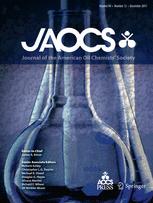Ver ítem
- xmlui.general.dspace_homeCentros Regionales y EEAsCentro Regional Mendoza - San JuanEEA San JuanArtículos científicosxmlui.ArtifactBrowser.ItemViewer.trail
- Inicio
- Centros Regionales y EEAs
- Centro Regional Mendoza - San Juan
- EEA San Juan
- Artículos científicos
- Ver ítem
Contribution of Compositional Parameters to the Oxidative Stability of Olive and Walnut Oil Blends
Resumen
Oil blending was conducted to study the effects of changes in fatty acid composition (FAC), tocopherols and total phenol content (TPC) on oxidative stability of virgin olive oil (VOO):walnut oil (WO) blends. The measurement of the antioxidant activity of bioactive components present in the parent oils and blends was achieved by their ability to scavenge the free stable 2,2-diphenyl-1-picrylhydrazyl radical (DPPH·). The highest percentage of DPPH·
[ver mas...]
Oil blending was conducted to study the effects of changes in fatty acid composition (FAC), tocopherols and total phenol content (TPC) on oxidative stability of virgin olive oil (VOO):walnut oil (WO) blends. The measurement of the antioxidant activity of bioactive components present in the parent oils and blends was achieved by their ability to scavenge the free stable 2,2-diphenyl-1-picrylhydrazyl radical (DPPH·). The highest percentage of DPPH· inhibition was found for pure VOO, and the lowest one for pure WO. EC50 values obtained from the DPPH assay correlated significantly and inversely with TPC. The generation of volatile flavor components in VOO indicated the predominance of C6 compounds produced through biochemical (enzymatic) pathways, whereas WO showed increased concentrations of medium chain (C7-C11) aldehydes produced through chemical (oxidative) pathways. The results obtained confirm the importance of VOO phenolics in providing protection against oxidation in VOO and VOO/WO blends. However, considering the impact of FAC and the content of endogenous antioxidant substances mentioned previously on the oxidative stability of the oils analyzed, the effect of an elevated unsaturation level (WO) prevails over a high amount of such bioactive components
[Cerrar]

Autor
Torres, Myriam Mariela;
Martinez, Marcela;
Pierantozzi, Pierluigi;
Albanese, Maria;
Nasjleti, Agustìn;
Maestri, Damian;
Fuente
Journal Of The American Oil Chemists Society 88 (6) : 755-762 (2011)
Fecha
2011-06
ISSN
0003-021X (Print)
1558-9331 (Online)
1558-9331 (Online)
Formato
pdf
Tipo de documento
artículo
Palabras Claves
Derechos de acceso
Restringido
 Excepto donde se diga explicitamente, este item se publica bajo la siguiente descripción: Creative Commons Attribution-NonCommercial-ShareAlike 2.5 Unported (CC BY-NC-SA 2.5)
Excepto donde se diga explicitamente, este item se publica bajo la siguiente descripción: Creative Commons Attribution-NonCommercial-ShareAlike 2.5 Unported (CC BY-NC-SA 2.5)

